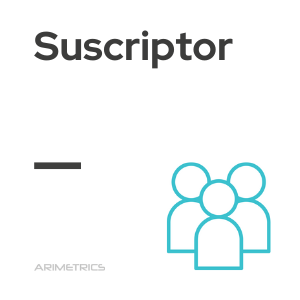 Definition:
Definition:
A subscriber is a person who has intentionally shared his or her personal data with a brand, providing information such as name, address and email address. Subscription can be triggered by a variety of reasons, such as purchasing a product, registering on a website or participating in an active promotion. In return, subscribers receive periodic notifications and updates.
What is a subscriber for?
A subscriber represents a long-term relationship and a potential source of revenue for the company. Already interested in the brand, a subscriber is a lead that is more likely to become a customer. In addition, a satisfied subscriber can act as a brand ambassador, helping to spread the word about your services and attracting new consumers. In short, a subscriber can evolve in two beneficial directions: becoming a customer or a brand advocate.
How to get subscribers
To attract subscribers to your blog or website, it is essential to develop an effective strategy. Here are a few tips:
- Create a subscription form: It is essential from the start. A well-designed form motivates visitors to leave their email to receive updates. Make sure the design reflects the brand’s corporate identity.
- Visible location: The form should be in strategic places, such as the home page or at the end of articles. Pop-ups are also common, although they may be considered intrusive by some users.
- Offer an incentive: Providing something in return can be effective. Depending on the industry, this could be a free ebook, a no-cost consultation or a discount on the first purchase. Originality is key, as competitors will also be using similar tactics.
- Exclusive content: Offering exclusive content can have a high conversion rate. Although not always easy to implement, depending on the sector, the idea is to provide material that complements what is already published.
- Resources section: Including a section with resources, such as a glossary of terms, useful links or downloadable material, can be attractive to readers.
- Disclose relevant data: Showing testimonials, the number of subscribers or any other relevant information can serve as a psychological incentive.
Strategies to retain subscribers
Once you have built a list of subscribers, it is critical to implement strategies to retain them and keep their interest for the long term. Here are some effective tactics:
- Regular communication: Maintaining a constant flow of communication through email marketing with subscribers is key. Sending newsletters, product updates or exclusive content on a regular basis helps to maintain interest and connection with the brand.
- Content personalization: Use subscriber data to personalize the content they receive. This can include product recommendations based on past purchases or content tailored to their specific interests.
- Loyalty programs: Implement loyalty programs that reward subscribers for their loyalty. These programs can include exclusive discounts, early access to new products or services, and reward points that can be redeemed for additional benefits.
- Surveys and feedback: Engage subscribers by asking for their opinion on products, services or content. Surveys not only provide valuable information, but also make subscribers feel valued and heard.
- Value-added content: Provide content that not only informs, but also educates or entertains. This can include webinars, tutorials, or expert articles that offer added value beyond product offerings.
